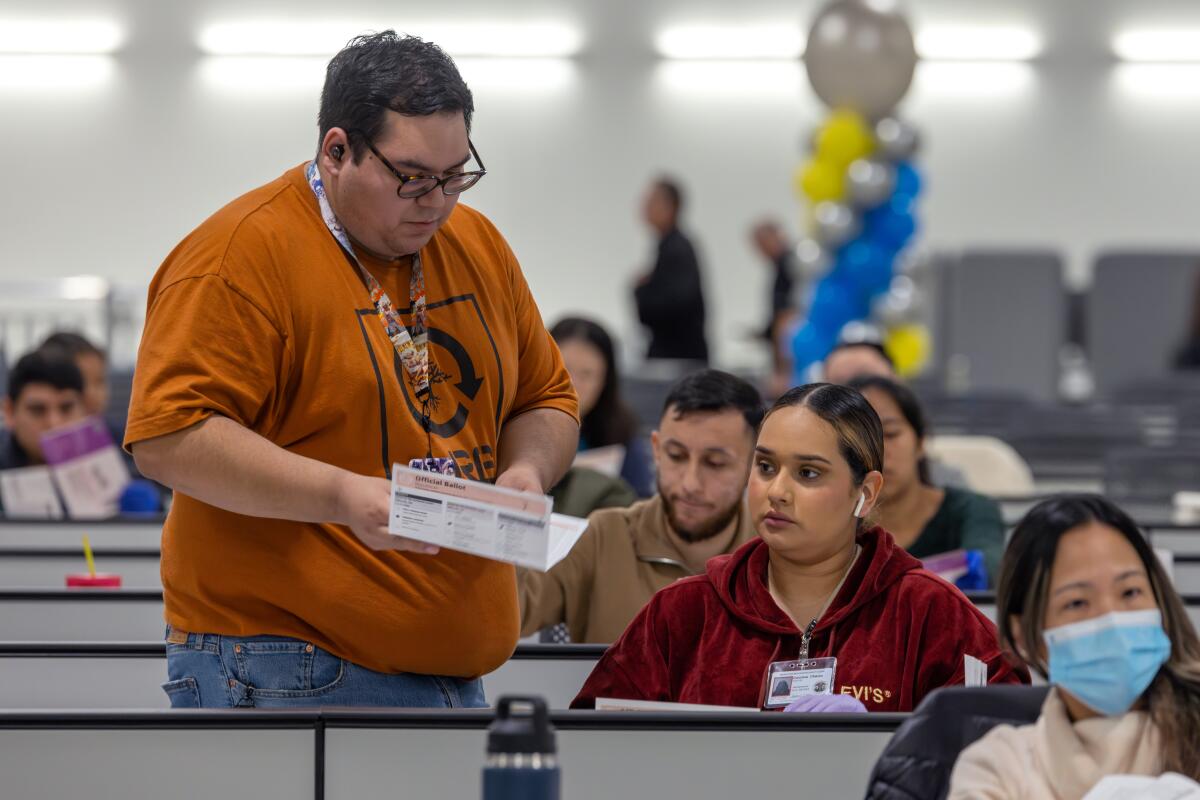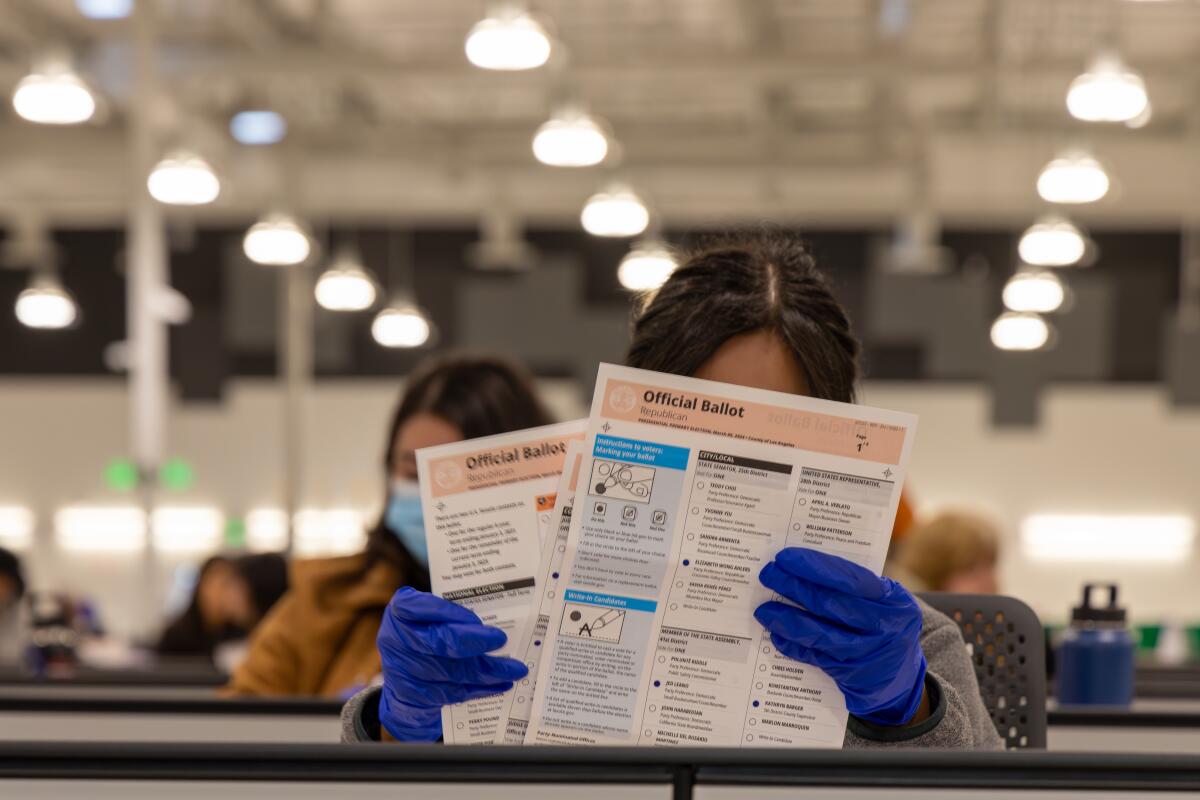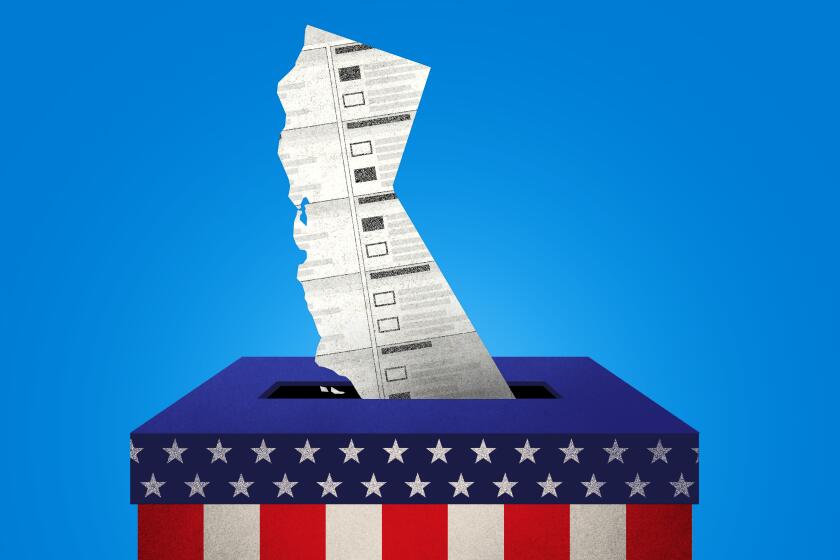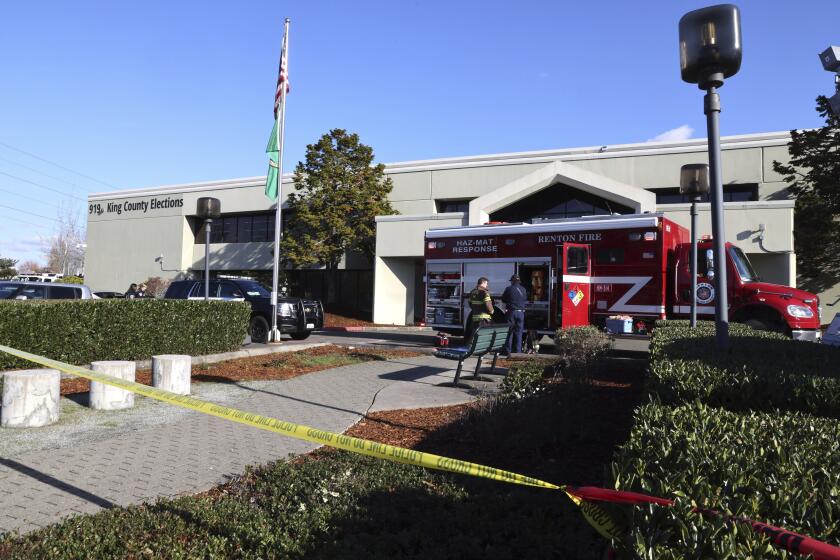L.A. County has a new ballot processing facility. Here’s how you can observe

Every ballot sent in on or before election day 2024 will take a trip to the City of Industry where it will be inspected and counted.
- Share via
When a Los Angeles County resident mailed in their ballot in 2020, it took a circuitous journey from Pomona to Downey to Santa Fe Springs.
But starting with the March 5 primary election, every ballot will be tabulated in one place: the L.A. County Ballot Processing Center in the City of Industry, a 24-hour secured facility that previously housed a Fry’s Electronics.
“It’s 144,000 square feet, and to the naked eye, it may look as though this is a big room with lots of moving people in it,” said Chief Deputy Jeramy Gray of the L.A. County Registrar-Recorder/County Clerk’s office. “But when you look closer, it’s a lot more than that.”
Four years ago, L.A. County introduced a new voting model and started mailing ballots to every registered voter. County officials said they learned through that process that they needed an all-in-one facility to process ballots. They used the old Fry’s building in 2022 for vote-by-mail operations and agreed it would serve as the best option.

Officials said the initial cost was about $10 million, which included the initial rent and build-out of the facility. Workers had just under a year to complete construction and get the facility ready for March.
The county has set up stations across the facility, where workers are busy processing about 146,000 ballots already sent in for the upcoming election.
California’s primary election takes place on March 5. Read up on the races in L.A. city, L.A. County and other areas.
On Saturday, L.A. County will open 119 vote centers, open from 10 a.m. to 7 p.m. until election day, when their hours will expand to 7 a.m. to 8 p.m.
On election day, ballots will be delivered by sheriff’s deputies by car and about seven helicopters. Deputies will also bring ballots by boat from Santa Catalina Island.
Until then, most ballots will arrive at the processing center either by U.S. Postal Service, usually in the morning, or in batches from the 35 teams that pick up ballots from more than 400 drop-off boxes across the county.

All ballots are first sniffed by a canine member of the L.A. County Sheriff’s Department checking for any drugs or dangerous substances. There’s a rotating shift of 12 handlers and their dogs.
If one of the dogs catches a whiff of something, it will sit and not move, focused on the general area where it noticed the odor.
In November, election workers in California and at least four other states received suspicious letters, some containing the powerful narcotic fentanyl.
That’s just one of many security concerns that county election workers face.
“Over the past six to eight years the nature of security around elections processes has become front and center,” Registrar-Recorder/County Clerk Dean C. Logan said Tuesday. He cited cybersecurity threats, nation-state actors who try to disrupt elections and “very aggressive” observers who have tried to attack or disrupt the process.

“Our belief is that we shouldn’t limit the opportunities for people to vote,” said Logan, who has held his position since 2008. “We should increase the security to ensure that they have that opportunity and that they know that we’re going to handle their ballot properly.”
Vote-by-mail and drop-off ballots are sorted and sent to automatic signature recognition machines, where ballot envelopes are scanned and the machine takes images of the signature to match it with the voter’s record. If it is verified, the ballot will be stored until workers are ready to process it further.
If the machines cannot verify the signatures, teams working on dozens of computers view the signatures side by side on their screens to compare them. If this second step does not provide verification, workers can ask for help from a team lead.
To open the ballot envelopes, workers use large, industrial letter-opening machines.
Next, workers who take the ballots out of their envelopes determine whether envelopes are empty, whether ballots need to be remade, or whether ballots are clear for the next step.
If a ballot is torn or perhaps stained after a voter spilled coffee on it, it probably won’t go through the tallying machine. Through a three-level verification process, workers in the “remake” area will remake the ballot to match the voter’s choices from the damaged ballot.
Once ballots are processed and prepared, they are ready to be tallied.
Authorities are trying to determine who sent suspicious letters, including some containing fentanyl or other substances, to local election offices.
The tally room in the processing center is surrounded by windows and is under 24/7 video surveillance.

It has 20 scanners to tabulate ballots, all of which will be running on election night. It is open only to a small number of workers, who must use key cards to enter, creating a log of who has gone inside.
“The activities on the scanners and the work that’s performed in there is all logged as well,” Logan said.
A metal partition wraps around the tally room where members of the public can observe activity in the tally room and elsewhere.
By election day, there will be about 750 workers at the various stations across the massive building.
Once the election is certified, ballots will be shipped to county warehouses for the required retention period of 22 months.
Anyone who wants to observe at the processing center can visit the L.A. County Registrar-Recorder/County Clerk’s website for times and dates when the public is allowed inside.
“It is very, very difficult to design a facility that is both highly secure but yet hyper accessible to the public,” Gray said. “And we had to balance both in this facility.”
More to Read
Sign up for Essential California
The most important California stories and recommendations in your inbox every morning.
You may occasionally receive promotional content from the Los Angeles Times.













